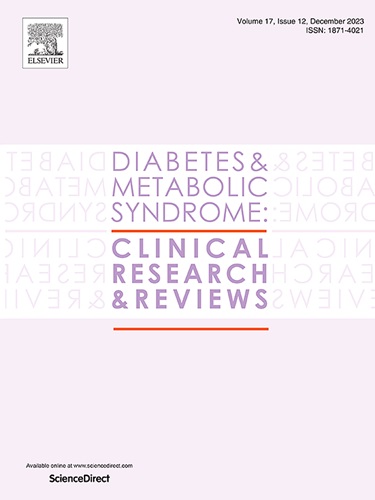bradford 1000队列研究中出生的儿童皮褶厚度轨迹的种族差异为脂肪组织隔室假说提供了适度的支持
IF 3.4
Q1 ENDOCRINOLOGY & METABOLISM
Diabetes & Metabolic Syndrome-Clinical Research & Reviews
Pub Date : 2025-05-01
DOI:10.1016/j.dsx.2025.103227
引用次数: 0
摘要
背景:南亚人群对心脏代谢疾病的易感性高,与特定体重指数相关的高肥胖。这项研究验证了脂肪组织溢出假说,即与欧洲白人相比,南亚人有更小的外围皮下脂肪组织库。方法在6、12、18、24、36月龄时对英国白种英国人(561例)和英国巴基斯坦人(651例)进行肩胛下、肱三头肌和大腿皮肤褶皱的测量。1295人的数据可用。三个皮褶轨迹的线性样条模型是按种族和性别群体开发的,以便探索群体之间的平均时间变化。模型根据出生体重、妊娠期长短和妊娠糖尿病进行调整。结果不同皮褶部位的3年生长轨迹不同,生长模式不同。英国白人和英国裔巴基斯坦儿童的肩胛下皮褶厚度相似。校正后的三头肌皮褶在英裔巴基斯坦男孩和女孩中大多低于英国白人儿童。英裔巴基斯坦儿童调整后的平均大腿皮褶厚度大多低于英国白人儿童。结论本研究为脂肪组织溢出假说提供了一定的支持。需要在更大的出生队列中进行复制,并继续考虑潜在差异对心脏代谢的影响。本文章由计算机程序翻译,如有差异,请以英文原文为准。
Ethnic differences in skinfold thickness trajectories in children in the born in bradford 1000 cohort study provide modest support for the adipose tissue compartment hypothesis
Background
South Asian populations have high susceptibility to cardiometabolic diseases, with high adiposity for a given Body Mass Index implicated. This study tested the adipose tissue overflow hypothesis that, compared to White Europeans, South Asians have smaller, peripheral subcutaneous adipose tissue depots.
Methods
Subscapular, triceps and thigh skinfolds were measured at 6, 12, 18, 24 and 36 months in White British (Number = 561) and British Pakistani (Number = 651) children in Bradford, England. Data were available for 1295 people. Linear spline models of the three skinfold trajectories were developed by ethnic and sex group to allow exploration of mean temporal change between groups. Models were adjusted for birthweight, length of gestation and gestational diabetes.
Results
3-year trajectories differed between skinfold sites, with different patterns of growth observed. White British and British Pakistani children had similar adjusted subscapular skinfold thicknesses. Adjusted triceps skinfolds in British Pakistani boys and girls were mostly lower than White British children. British Pakistani children had adjusted mean thigh skinfold thicknesses mostly lower than White British children.
Conclusion
Our study provides modest support for the adipose tissue overflow hypothesis. Replication in larger birth cohorts and continuing consideration of the cardiometabolic impacts of potential differences are required.
求助全文
通过发布文献求助,成功后即可免费获取论文全文。
去求助
来源期刊

Diabetes & Metabolic Syndrome-Clinical Research & Reviews
ENDOCRINOLOGY & METABOLISM-
CiteScore
22.90
自引率
2.00%
发文量
248
审稿时长
51 days
期刊介绍:
Diabetes and Metabolic Syndrome: Clinical Research and Reviews is the official journal of DiabetesIndia. It aims to provide a global platform for healthcare professionals, diabetes educators, and other stakeholders to submit their research on diabetes care.
Types of Publications:
Diabetes and Metabolic Syndrome: Clinical Research and Reviews publishes peer-reviewed original articles, reviews, short communications, case reports, letters to the Editor, and expert comments. Reviews and mini-reviews are particularly welcomed for areas within endocrinology undergoing rapid changes.
 求助内容:
求助内容: 应助结果提醒方式:
应助结果提醒方式:


